| |
DR. JOSE P. RIZAL
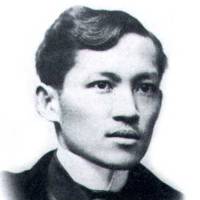
Philippine National Hero
June 19, 1861 - December 30, 1896
Jose Protacio Rizal our National hero, was born in Calamba Laguna on June 19, 1861 to Francisco Mercado and Teodora Alonzo.
With his mother as his first teacher, he began his early education at home and continued it in Biñan, Laguna. He finished Bachiler en Artes at the Ateneo de Manila on March 23, 1876 with highest honors. In 1877 he took up medicine at the University of Sto. Tomas and surveying in 1885 at the Central University of Madrid. In Europe, he took graduate studies in Paris and Heidelberg. He learned to read and write different languages including Greek and Latin.
|
ANDRES BONIFACIO
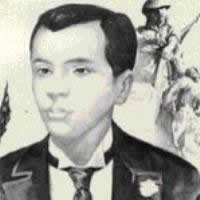
The Great Plebeian and Founder of the Katipunan
November 30, 1863 - May 10, 1897
Andres Bonifacio was born to Santiago Bonifacio and Catalina de Castro a Spanish mestiza in a shack in Tondo, Manila on November 30, 1863.
He started his early education in the school of Guillermo Osmeña of Cebu. He reached only primary school, at the age of 14 his father and mother died, forcing him to quit his studies and to look after his younger brothers and sisters. As a means of support, he had them help him make wood canes and paper fans, which he sold in the streets.
Having learned how to read and write, he became a clerk messenger of Fleeming and Company, a business firm dealing with rattan, tar and other articles of trade. Because of his industry he was promoted as agent. But his earnings were still not sufficient to support the orphans. He moved to Fressell and company as an agent. He showed such determination and industry in his job that made him hold it. He supplemented his low educationg through reading and self study. Among the few books he read were Rizal's novels, the lives of President, Victor Hugo's Les Miserables, the ruins of Palmyra and French Revolution. Those books prodded his spirit of rebellion to act and gave him impulse to organise the Katipunan.
|
MELCHORA AQUINO
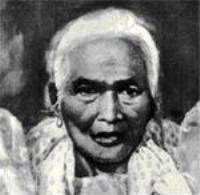
Tandang Sora
The Grand Old Woman of Balintawak
1812 - 1919
Born in Banilad, Caloocan, on January 6, 1812, Melchora Aquino is known as Tandang Sora in Philippine history because she was already old when the Philippine Revolution broke out in 1896. She had never gone to school and very little is known about her parents save that they were poor hardworking parents.
Tandang Sora was tending a small sarisari (variety) store in Balintawak when Andres Bonifacio and the other Katipuneros staged the First Cry of Balintawak that started the Philippine Revolution. Her store became a refuge for sick and wounded Katipuneros whom the old lady led, treated and encouraged with her motherly advise and prayers. Thus, she was aptly called the "Mother of Katipunan." When the Spaniards learned about her activities, she was arrested and deported to Marianas. When the Americans took possession of the Philippines in 1898, Tandang Sora, like the other exiles returned to the Philippines poor, and aging. For a time she lived with her daughter Saturnina.
On March 2, 1919, she died at the age of 107.
|
GREGORIO DEL PILAR
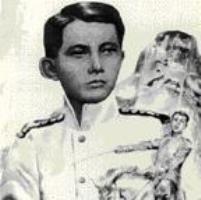
Hero of Tirad Pass
November 14, 1875 - December 2, 1899
"I am surrounded by fearful odds that will overcome me and my gallant men, but I am pleased to die fighting for my beloved country."
Gregorio del Pilar, born in San Jose, Bulacan on November 14, 1875, considered the Hero of Tirad Pass and one of the most romantic figures in Philippine history wrote these words before he died. Courageous and unyielding, this young general fought and held back the strong invading Americans even with just a handful of men to support him. Alas, on that fateful day of December 2, 1899, while commanding Emilio Aguinaldo's rear guard, he was killed .
The Americans did not stop there. It desecrated the hero's deeds and death as they looted the corpse of the fallen general. They took his pistol, diary and personal papers, boots and silver spurs, coat and pants, a lady's handkerchief with his sweetheart's name "Dolores Jose" embellished on it, diamond rings, gold watch, shoulder straps and a gold locket containing a woman's hair.
But a chivalric American officer, by way of redeeming his countrymen's willful destruction, gave the late hero an honorable burial, with the words "An officer and a gentlemen" inscripted on his tombstone.
|
MARCELO H. D.EL PILAR
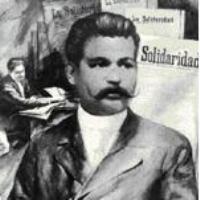
Greatest Journalist of the Propaganda Movement
August 30, 1850 - July 4, 1896
Born on Kupang, San Nicolas, Bulacan on August 30, 1850 with Julian del Pilar and Blasa Gatmaitan as his parents, Marcel H. Del Pilar supported the Philippine Revolution with his editorial wisdom.
In 1882, he was editor of "Diariong Tagalog" which criticized Spanish rule. Using the pen name "Plaridel," he wrote satires against the Spanish friars, notably "Dasalan at Tuksuhan" and "Kaiingat Kayo."
When in Spain, he succeeded Graciano Lopez Jaena as editor of the "La Solidaridad," the mouthpiece of the propagandists working for reforms in the Philippines. But his illness kept him from holding that position for a long time. Soon, tuberculosis weakened him and he died on July 4, 1896 in Barcelona, Spain, away from his family.
|
APOLINARIO MABINI
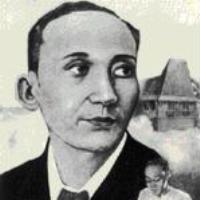
The Sublime Paralytic and the Brains of the Revolution
July 23, 1864 - May 13, 1903
Apolinario Mabini was born in the barrio of Talaga, Tanauan, Batangas, on July 23, 1864. The second son of Inocencio Mabini and Dionisia Maranan.
Mabini obtained his early education from his grandfather and his mother, who taught him the rudiments of reading writing and arithmetic later, he enrolled in the primary school of Simplicio Avelino supporting himself by working a muchacho. During his third year in high school, Mabini won first prize, a silver medal and a diploma of honor for the course in Universal History, in a competition for scholarship conducted by the college of San Juan de Letran in Manila. He was able to obtain a new teaching position in the school of Sebastian Virrey.
In March 1887, desirous of continuing his studies, Mabini took and passed the required examination at the university of Santo Tomas, obtaining the degree of Bachelor of Arts completed the course in 1894. In the examination for Licentiate in Jurisprudence on March 2, 1894, he obtained the grade of 'excellent'. He became a copyist in the court of first Instance of Manila.
It was in January 1896 that he contracted a severe fever which resulted in his permanent paralysis. His physical condition prevented him from taking a more active part in the revolutionary movement. Despite of his physical condition, Mabini played a prominent part in the second period of revolution. He planned the revolutionary government and acted as the Prime Minister of President Emilio Aguinaldo. He occupied the positions of President of the Government council and secretary of Foreign affairs. His programa constitutional dela Republica Filipina was one of the models of the Malolos constitution. His works earned for him the title 'brains of the revolution' as well as the 'sublime paralytic.' In August 1899, the revolutionary congress elected him chief justice of the supreme court.
Mabini was captured by the American's in December 1899. He was released from prison on October 3, 1900. He lived in a small nipa house in Manila where he barely supported himself writing political articles. (El Simil de Alejandro) prompted the Americans to exile him to the island of Guam. After August 1901, because of his refusal to sign the required oath of allegiance to the U.S. after 17 months, he was convinced of the sincerity of American's good intentions in his country, he agreed to take the required oath. He was back in the Philippines on February 26, 1903.
Mabini died of cholera in Manila on May 13, 1903 at the age of 39.
|
EMILIO JACINTO
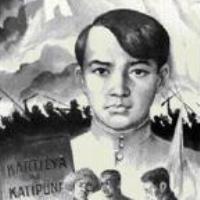
Brains of the Katipunan
December 15, 1875 - April 16, 1899
It was his sad experiences with his Spanish classmates and sensitivity to the plight of the Filipinos as caused by the injustices of the Spaniards that led Emilio Jacinto to become a Katipunero.
Born in Trozo, Manila on December 15, 1875, Jacinto's early education was supported by his widowed mother who worked as a midwife. Later on, his uncle enrolled him at the San Juan Letran College after which he took Law at the University of Santo Tomas.
It was the need to join the Katipunan that interrupted the young man's studies as he was only 19 years old when he joined it. Even at that young age, he became one of the ablest leaders of the movement. To Bonifacio, he was an adviser, a secretary and a fiscal. A gifted writer, Jacinto was also the editor of "Ang Kalayaan," the movement's newspaper. He also wrote the "Kartilla," its primer containing the movement's rules and regulations. Also a poet, he wrote "A La Patria," which was inspired by Dr. Jose Rizal's "Mi Ultimo Adios," under the pen name of Dimas Law. He also supervised the manufacture of gunpowder. Thus, the title of "Brains of the Katipunan" was bestowed on him.
Alas, like most heroes, his life has to be taken while serving his fellow countrymen. Jacinto, mortally wounded in one of the battles in Majayjay, Laguna died on April 16, 1899 at the age of 24.
|
ANTONIO LUNA
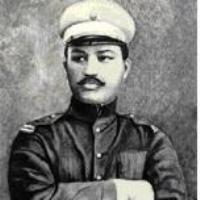
Greatest General of the Revolution
October 29, 1866 - June 5, 1899
General Antonio Luna was born in Binondo, Manila on October 29, 1886 to Joaquin Luna de San Pedro and Laureana Novico. He was the youngest of the seven children.
A pharmacist by profession and military officer by force of circumstances, Antonio started learning at the age of six in a private school. Two years later he transferred to the Ateneo Municipal de Manila and in 1891 obtained his Bachelor of Arts degree. He enrolled at the University of Barcelona where he finished with the degree if Licenciate in Pharmacy. He continued his studies in the University of Madrid and obtained his Doctor of Pharmacy in 1890. Antonio was also a man of letters, at the age of 19 he won first prize in a literary competition with his competition in titled Dos Cuerpos Fundamentales de la Quicama. He also wrote articles for La Independencia a new paper he founded and edited. He had been a contributor to various periodicals and magazines local and international such as El Siglo Medico, La Farmacia Espanola, La Ilustracion Filipina and La Revisita Parmaceutica.
Soon after the outbreak of the revolution, Luna was suspected of being a Filibuster. He was arrested and tried in September 1896 and in 1897 sent to Spain as an exile. Through the influence of his brother Juan. The well known painter, he proceeded to Ghent, Belgium and studied military science. Gen. Aguinaldo appointed him director of war and commanding general of the army with the rank of Brigadier General. At Cabanatuan, Nueva Ecija in answer to General Emilio Aguinaldo's summons for a supposed conference. He was assassinated there on June 5, 1899.
|
JUAN LUNA
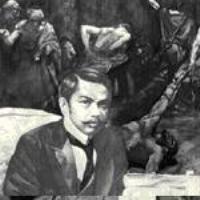
The Greatest Filipino-Painter
October 23, 1857 - December 7, 1899
Born in Badoc, Ilocos Norte on October 23, 1857 with Joaquin Luna and Laureana Novicio as his parents, Juan Luna is the creator of the world-famous painting "Spolarium."
He studied at the Ateneo de Manila, enlisted for the maritime services but had to quit because he pursued his studies in painting. In 1877, he sailed for Barcelona and made his debut as a professional painter in 1880 with "The Death of Cleopatra," which won second prize in the Madrid Exposition and was purchased by the Spanish government. It is now on permanent exhibit in the Museo Nacional de Pinturas, Salon de Pinturas Modernas in Madrid..
His "Spolarium" garnered him a gold medal in the Exposicion Nacional de Bellas Artes in Madrid in 1884. It fetched 20,000 pesetas in 1886 when sold to the Diputacion Provincial de Barcelona.
In October 1884, he transferred his studios to Paris and on 1896 married Paz Pardo de Tavera. When he went back to Manila after 17 years, he was imprisoned being a suspect during the outbreak of the Revolution. He was pardoned by the Queen Regent on May 27, 1897.
In 1898, he represented the country in a peace discussion. He died on December 7, 1899 in Hongkong of heart attack.
|
FATHER JOSE BURGOS
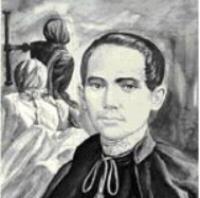
The young and most brilliant of the martyr-priest of 1872
February 9, 1837 - February 17, 1872
Father Jose Burgos, the youngest among the three Filipino martyr-priests (Fathers Mariano Gomez and Jacinto Zamora) was born in Vigan, Ilocos Sur on February 9, 1837 with Jose Burgos and Florencia Garcia as his parents.
His first teacher was his mother, who taught him how to read and write. At the age of 17, he finished Bachiller en Artes with honors, studied priesthood at the University of Santo Tomas and said his first mass at the Parroquia del Sagrario de Intramuros.
Father Burgos earned the title "Champion of the Cause of Filipino Clergy" yet his courageous efforts irked the Spanish friars. Thus, when the Cavite mutiny took place in 1872, the Spanish authorities arrested him together with Fathers Gomez and Zamora for they were thought to have incited the revolution. They were executed at Fort Santiago, Bagumbayan, now Luneta, on February 15, 1872.
|
|
|